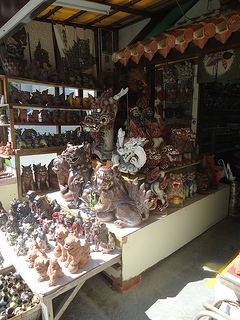Ryukyuan pottery

- Okinawan: 焼物 (yachimun)
Pottery was first introduced to Ryûkyû from China during the Gusuku Period (c. 1100s-1400s). Tsuboya wares, produced in the Tsuboya district of Naha, are the most well-known style of Ryukyuan pottery, and the most strongly associated with Ryûkyû. In addition to dishes, vessels, and roof tiles, Ryukyuan pottery is especially known for the production of funerary urns, and shisa, lion-like guardians placed on rooftops and at gates to protect homes and other spaces from evil spirits.
The court ordered many of the potters in the kingdom to relocate to the Tsuboya district in 1682, creating Tsuboya as a major center of pottery production, and sparking the emergence of a distinctive Tsuboya style. Kumejima, Miyakojima, and Ishigakijima remain major centers of pottery production as well.
In Okinawa, the terms jôyachi (上焼, "completed wares") and arayachi (荒焼, "rough wares") are used to refer, respectively, to glazed and unglazed ceramics.
References
- Gallery labels, Okinawa Prefectural Museum.